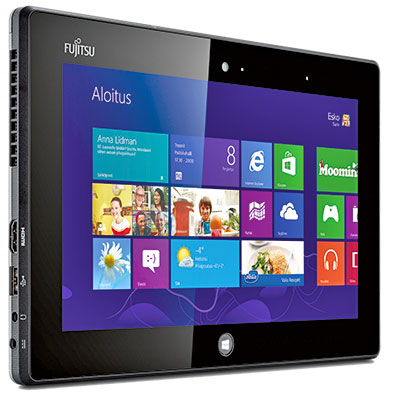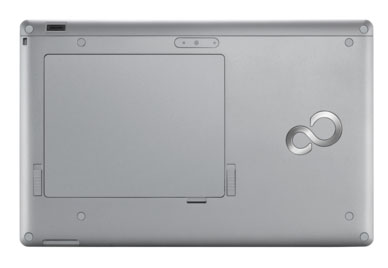In October 2012, Fujitsu announced the Stylistic Q572 as a business-class tablet for mobile professionals. While at first sight identical to the Stylistic Q550, the Q572 is really a different product and design, one that includes what the company learned from the Q550 and also one better suited for Windows 8 that Microsoft released at about the same time.

As it, the Q572 is facing a market that is very different from the one Fujitsu once dominated with its pen slate and tablet designs going back to the early 1990s. To recap that past glory, over the years we were impressed with the design, high quality, and overall execution of the Stylistic ST6000 Series of Tablet PCs, the successor to a long line of ST5x00, ST4000 and earlier Stylistic pen computing slates. For a while, Fujitsu all but stopped selling tablets and instead concentrated on a line of convertible Tablet PCs such as the LifeBook T5010, T4410, T2010, and ultra-mobile convertibles such as the LifeBook U820.
While those convertible LifeBooks were (and are) very nice, they mostly represented low volume niche products compared to the booming tablet market where Apple sold almost 20 million iPads in the first quarter of 2013 alone, and the rest of the tablet industry another 30 million. This is by any standard a formidable opportunity for a company as experienced in tablets as Fujitsu. So what does Fujitsu offer with the Stylistic Q572?

The hardware itself is standard tablet fare, combining the uniquitous iPad look with a flush black front and silvery back with some more traditional Japanese electronics design elements. The display size is 10.1 inches diagonally like the Q550 that used a 16:10 format, but Fujitsu chose the even wider 16:9 aspect ratio for the Q572 (Apple believes in the 4:3 aspect ratio for its tablets). Resolution is 1366 x 768 pixel, which is also what Microsoft sort of mandated as a minimum for Windows 8 tablets. The IPS display has anti-glare treatment, a wide 160 degree vewing angle from all directions, and claims outdoor viewability with a strong 400 nits LED backlight.
One area where the Stylistic Q572 trumps the iPad and almost every other tablet is in its N-trig DuoSense dual input that combines capacitive multi-touch with an an active pen. It's an auto-sensing arrangement that automatically switches between touch and pen. Having a pen for applications and tasks that require precise input or drawing is a big advantage, and it certainly also comes in handy for those opting for the the mouse-oriented Windows 7 (or spend a lot f time in legacy apps in Windows 8). The pen, though, is different from the ubiquitous Wacom pen in that it does need a battery. It's a tiny AAAA that is said to last about a year and a half.
The Q572 measures 10.8 x 6.9 inches and it is 0.54 inches thick—making it a bit narrower and thinner than the old Q550. It's also about the size of Microsoft's Surface RT tablet, albeit a bit thicker. Weight, with the standard battery, is 1.65 pounds, which is portly by today's consumer media tablet standards, but a featherweight compared to older Tablet PCs. That weight, though, includes a nicely sized 36 watt-hour battery that's far more powerful than the modest 13 watt-hour pack in the old Q550. Depending on what Fujitsu literature one looks at, this should be good for about six hours.
Now what did put Fujitsu under the hood of the Q572? By using an AMD Z-60, the company in essence followed the pattern seen in the by now pretty much extinct netbooks where one generation of underpowered Intel Atom chips was replaced by another, and then by AMD APU (Accelerated Processing Unit) processors. The Z-60 was introduced towards the end of 2012 with the promise of combining a decent CPU and superior graphics into one package. What makes the choice interesting is that Intel had introduced the Atom Z2760, which was specifically designed for tablets and also has a lower TDP than the AMD chip. Also of note is that the netbooks that had tried AMD processors as a more powerful alternative to Intel Atom CPUs ended up returning to Intel, and using late model Celeron chips.
For memory is 2 or 4GB of DDR3 SDRAM, and you can get either a 64, 128, or even 256GB solid state disk. There are two USB port, HDMI, a standard 3.5mm audio jack, docking port and two cameras. The front webcam does 1280 x 720 pixel, the 5mp rear documentation camera can do full 1080p video. There's WiFi and Bluetooth, and also optional Gobi 3000 with GPS, which means carrier and communications technology independence.
The Q572 is usually shown with Windows 8, for which is primarily seems developed, but it can also run Windows 7, either the 32-bit ot the 64-bit version. When the Q572 was introduced, expectations for Windows 8 were high, but as of May 2013, Windows 8 still has failed to gain much traction, and according to IDC, the overall Windows marketshare in tablets for 1Q13 was just 3.3%. Still, Windows is Windows and, especially in the enterprise, that still means a giant selection of industrial strength software, programming and integration leverage, good security, and general compatibility with everything else in an existing IT infrastructure.
How about ruggedness? Not much info here. Japanese companies are notoriously conservative with their environmental specs, and so the Q572 is listed with a very narrow 41° to 95°F operating temperature range and nothing more. That is a bit limiting in a business-class market, especially when the competition generally aims to offer semi-ruggedness. In all fairness, Fujitsu's specs do include a link to an independent MIL-STD-810G testing document for the Q572 that lists the results of nine tests (including a 2.5-foot drop spec), but it's not the kind of data enterprise customers use and understand.
Price has always been an issue with tablets. Initially that wasn't much of a problem as tablets were viewed as very specialized vertical market products with a hefty price to match. The iPad permanently changed that as tablet pricing for consumer and even business tablets is now excepted to be in the hundreds of dollars, and not in the thousands. Fujitsu meets that challenge with a starting price of US$879. That's more than the old Stylistic Q550, but much less than traditional semi-rugged business and industrial tablets.
It's hard to say where that leaves the Stylistic Q572. The tablet market is huge, but even the enterprise seems to be buying mostly iPads and Samsung's Android tablets (Samsung sold a stunning 8.8 million in 1Q13 alone). Given Fujitsu's reputation, tradition, and quality, the company ought to sell boatloads of Q572s, but the tablet just sits in an awkward position what with Microsoft's tiny tablet marketshare and own forays into the tablet market with their surface hardware. Still, the Q572 does have a lot going for itself by offering both multi-touch and pen, large capacity storage, and Fujitsu service and know-how, all for a very attractive price.







